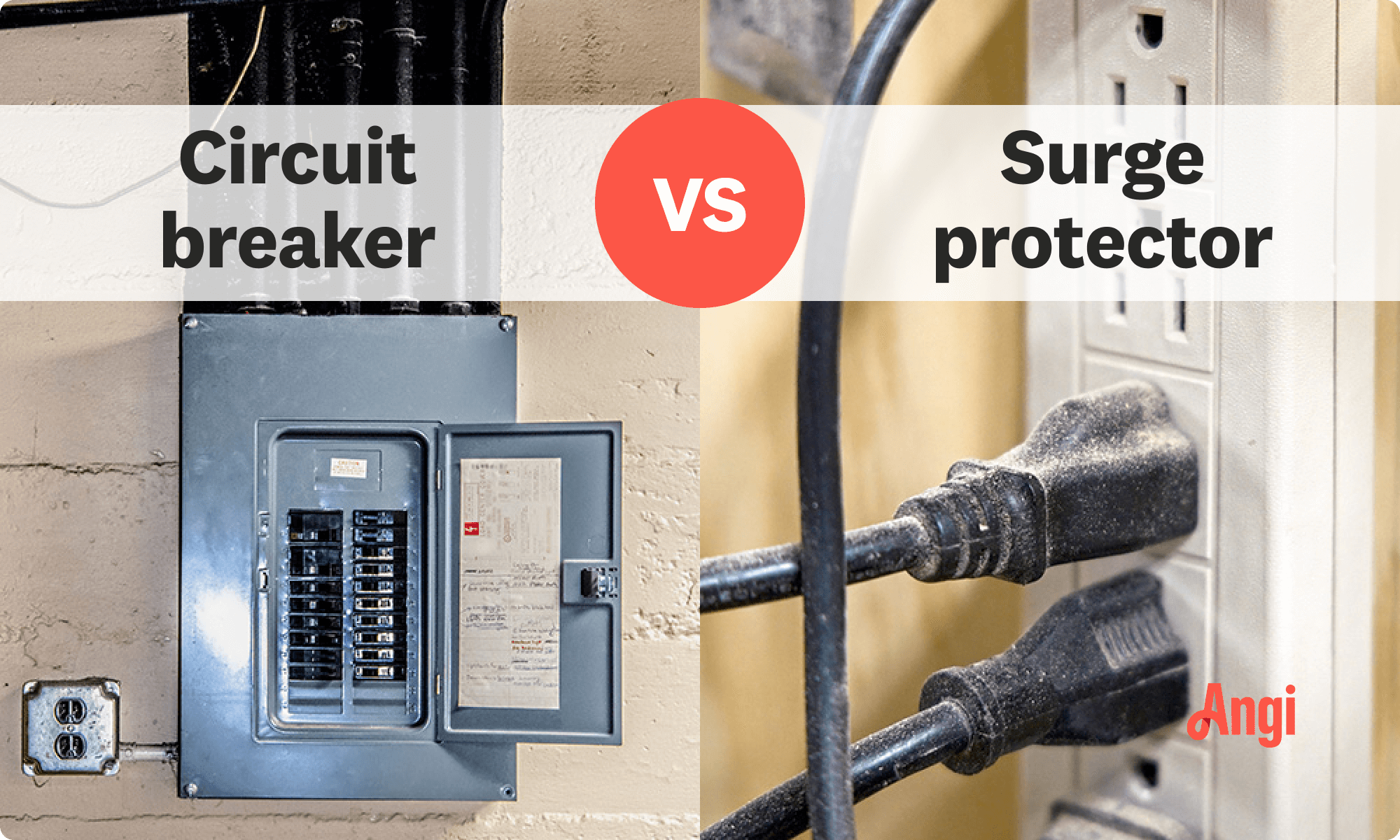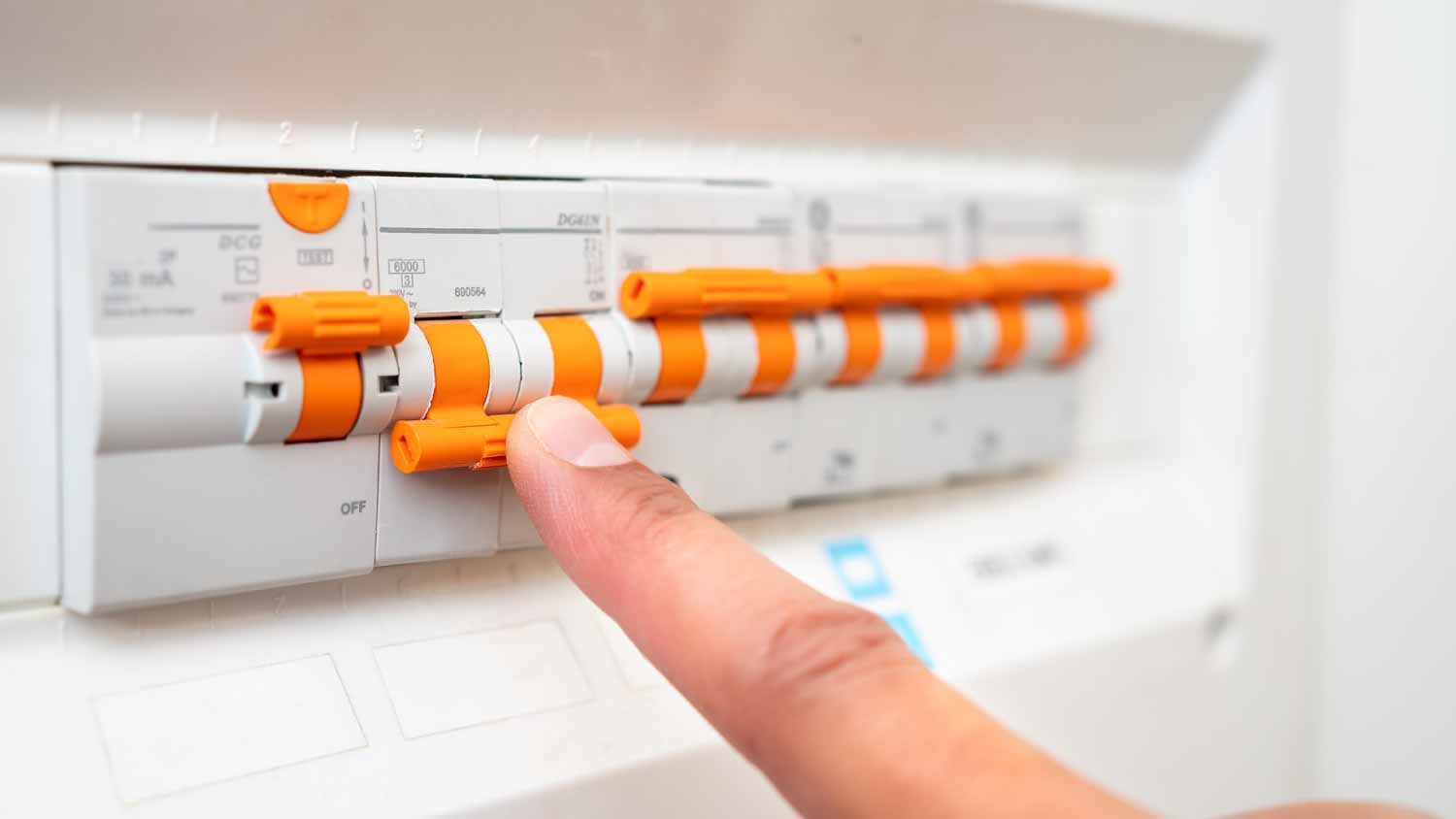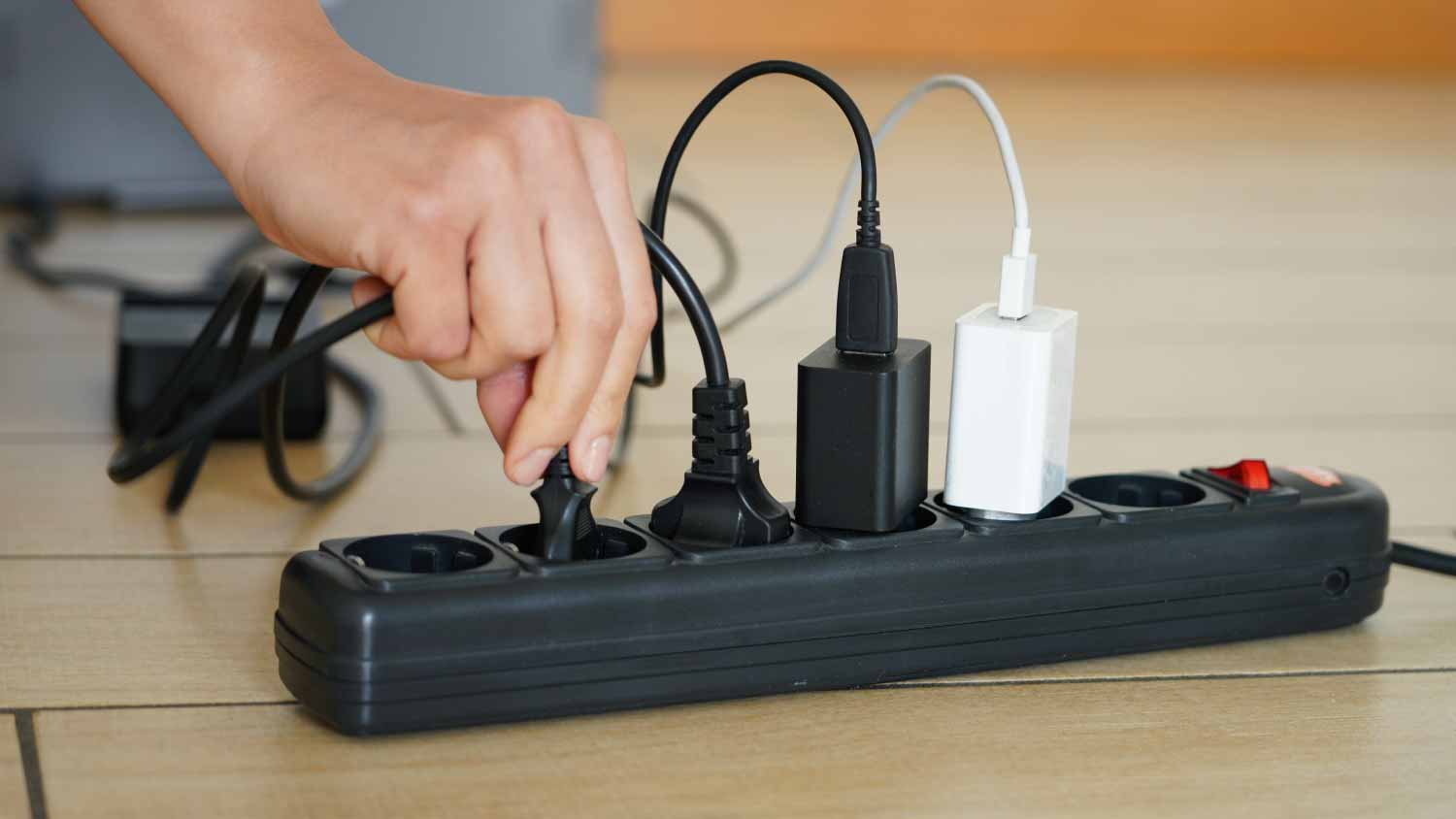
The average cost to install an electrical outlet is $133 to $296 each. This guide explains what factors impact the total cost of installing an outlet.
The nuts and volts behind these two electrical protectors


Circuit breakers specialize in cutting circuits if an amp overload is detected, like plugging in too many Christmas lights.
Surge protectors specialize in minimizing damage from voltage spikes, resulting from lightning strikes and other sources.
Circuit breakers are whole-house solutions and typically housed in a breaker box, with different breakers for specific rooms and large appliances.
Surge protectors are available as whole-house installations in the breaker box, but they are more common as portable, plug-in devices to protect sensitive electronics like computers.
Today’s homes are better protected against electrical shocks and related damage than ever before. Two of the most important defenders are circuit breakers and surge protectors, which you can find in nearly any home.
Both devices work by interrupting electrical current before damage or fires can happen. However, you shouldn’t get these two options confused. They work in different ways and have very different applications. Our guide will clear up the confusion and show you which is best to mitigate your electrical risks.

Circuit breakers and surge protectors protect your home from different kinds of electrical overloads. Circuit breakers cut electricity to circuits in the event of an amp overload, while surge protectors minimize damage from sudden voltage spikes, such as a lightning strike.
Another key difference is that circuit breakers are whole-home solutions that protect large appliances via the breaker box, and surge protectors are more commonly used as portable devices that plug in to protect electronics. However, you can also use a whole-home surge protector that’s installed into your breaker box. Consult a local electrician to determine which option best suits your home’s current electrical needs.

Circuit breakers are designed to interrupt the flow of electricity when something goes wrong, stopping the electrical current. These electrical components are built into home electrical systems by default, although you can replace, add, or upgrade them.
Let’s say you fill your living room with Christmas lights that require multiple outlet plug-ins. But the living circuit is only designed for 15 amps of electricity. The entertainment system combined with the Christmas lights pushes the needed electricity above 20 amps. The circuit breaker detects this overload and flips the circuit off to prevent wires from overheating the system or causing a serious electrical fire.
Circuit breakers can also cut the connection if they sense things like a malfunctioning appliance, a short circuit, or another problem that’s putting too much strain on the electrical circuit. The breaker box houses circuit breakers for different areas of the home.
Note: Don’t confuse circuit breakers with ground fault circuit interrupters (GFCI). GFCIs are an electrical outlet feature that shuts off power to that specific outlet if they detect an unstable current, preventing shocks and similar problems. They are, in a sense, circuit breakers, but they only apply to one outlet and should not be confused with whole-home circuit breakers.
| Pros | Cons |
|---|---|
| Affordable | Doesn’t focus on specific electronics like computers |
| Protects an entire home and its systems | Doesn’t handle voltage spikes well |
| Long lifespan of 30 to 40 years | |
| Easy maintenance |
Best for:
Amp overload protection
Protecting whole homes and rooms
Upgrading from fuses
Adding protection to remodels
Circuit breakers protect the entire home at once. If you remodel or add a new room, you can add new circuit breakers. They last for 30 to 40 years and need little to no maintenance.
If a breaker flips, it’s easy to investigate the problem yourself, reduce the amp load on the circuit or make other changes, and turn the breaker back on. If you need professional repairs, breakers are relatively affordable to service. Replacing a circuit breaker switch costs $100 to $200.
Circuit breakers primarily work by measuring apps, or how much electricity is moving through wiring simultaneously. That means circuit breakers can’t always protect against sharp increases in voltage, or the strength of the electrical current, which is where surge protectors come in handy. You also can’t use circuit breakers to protect plugged-in devices on demand.

Surge protectors help protect connected devices from experiencing damage due to a sudden electrical power surge. An electrical surge occurs when the voltage flowing from the outlet and into devices suddenly spikes during a lightning storm or when a power line is damaged.
In many cases, circuit breakers will catch a surge and shut down the electrical current, but before that happens, devices can still experience a quick rush of voltage they can’t handle. That can cause damage to more sensitive components, from internal wiring to circuit boards and batteries.
Surge protectors act as a last line of defense for this problem. If they detect one of these spikes in voltage (as opposed to circuit breakers, which specialize in amps), they shut down the connection or increase the resistance for a plugged-in device, keeping it safe. It’s more limited than a circuit breaker, but still important for sensitive electronics.
| Pros | Cons |
|---|---|
| Versatile at protecting many types of devices | Expensive |
| Protects data and electronic components | Power strip versions only protect plugged-in devices |
| Often portable and plug in easily | Doesn’t handle amp overloads well |
| Add-on features available | |
| Whole-house option available |
Best for:
Protecting against voltage spikes like from lightning strikes
Consumer electronic protection
Adding extra features like energy tracking or scheduling
Surge protectors excel at protecting sensitive devices from damage due to lightning strikes and other causes of voltage spikes. They are highly recommended for computer set-ups and entertainment systems.
Surge protectors are also very versatile, as they’re available as portable power strips with extra outlets, USB ports, and smart features. Some versions are even available as whole-house surge protectors, although those are more rare.
A surge protector can’t protect entire rooms unless you install a whole-house surge protector. special versions are installed along with breakers. Whole-house surge protectors cost between $70 to $700, depending on the type and protection level.
Portable surge protectors aren’t suitable for some kinds of large appliances, focusing instead on consumer electronics. And while they specialize in tracking voltage, they aren’t as good at handling amp overloads, which are circuit breakers specialty.
The best option for defense against electrical fires, shocks, or damage to electronics will depend on what you most want to protect against.
Circuit breakers and surge protectors focus on different kinds of protection, making them both important. Circuit breakers detect when too many amps are flowing through home wiring, which can be caused by a sudden overload, too many devices connected to one circuit, and similar problems.
Surge protectors focus on voltage, watching for sudden power spikes in the electrical system that can fry sensitive electronics. Those spikes are typically caused by lightning strikes, fallen power lines, and other unexpected events. While their purposes are different, both provide valuable services in the home. Circuit breakers are seen as a bit more necessary, but surge protectors are highly recommended.
Circuit breakers cover all electrical circuits in the house, typically divided between rooms. Portable surge protectors are useful for their versatility since you can easily move them between outlets as necessary.
Additionally, you have the option to install a whole-house surge protector, which sits in your breaker box and monitors voltage.
Circuit breakers monitor the electrical current and flip it off when there’s a problem, allowing you to flip it back on. It’s as simple as can be.
On the other hand, surge protectors come in a vast array of shapes and sizes when paired with a power strip. They can lay on the floor, mount to a wall, hang from a desk or table, or plug straight into an outlet. They have shapes that can accommodate a number of tight areas, too.
The cost of replacing a main breaker switch is $200 to $300, while a complete circuit breaker box upgrade can cost up to $2,000. For that reason, circuit breakers are more expensive than installing surge protectors, but that expense is rarely necessary.
Surge protector costs are much more variable. Standalone, plug-in models may cost anywhere from $30 to $200, depending on the features. A whole-house surge protector costs between $70 and $700.
Circuit breakers and whole-house surge protectors don’t have extra features. However, plug-in versions of surge protectors offer plenty of extras like more outlets, USB ports, energy monitoring and power scheduling, even app-based controls. Just be careful when purchasing—not all power strips have surge protector capabilities.
Despite being connected to your electrical system, neither circuit breakers nor surge protectors use much power on their own. You won’t need to worry about any energy bill increases. In fact, advanced surge protectors with on/off scheduling may save you electricity.
Circuit breakers are ready for the long haul. Some models can last as long as 40 years. You won’t generally have to worry about a replacement until after 25 years.
Surge protectors aren’t delicate, but they won’t have that kind of lifespan unless you choose the durable whole-house version. Expect portable versions to last around 10 years at most.
Maintenance isn’t a major concern with these electrical components. Make sure there’s no dust buildup or concerns about moisture near the devices, and they’ll keep working away. The biggest difference is that circuit breakers and whole-house surge protectors need professional service when something goes wrong, while portable surge protectors can just be replaced.
Because of the electricity and work involved, circuit breaker installation is often a professional job. With the right protective equipment and experience, it can be a DIY project, but many homeowners will want to call in the pros instead. But many surge protectors are as simple to install as power strips, with a plug-in design that’s easy-as-can-be to use.
From average costs to expert advice, get all the answers you need to get your job done.

The average cost to install an electrical outlet is $133 to $296 each. This guide explains what factors impact the total cost of installing an outlet.

Updating broken and outdated light switches isn't as tricky as you might think. We'll cover the considerations and cost to install a light switch in this guide.

The cost to install a 240-volt outlet varies depending on the amperage and the home’s current wiring conditions. Use this guide to budget for your next project.

Today’s polarized plugs and outlets have a hot and neutral side, which is important for any receptacle wiring. Here’s what that means, why it happened, and how to take advantage of it.

Flickering lights and breaker trips can be a sign that it’s time to replace a circuit breaker. Find out the cost, safety tips, and how to replace a circuit breaker.

Finding the best electrician for your project starts with asking the right questions and checking credentials. Here are tips on how to find an electrician.